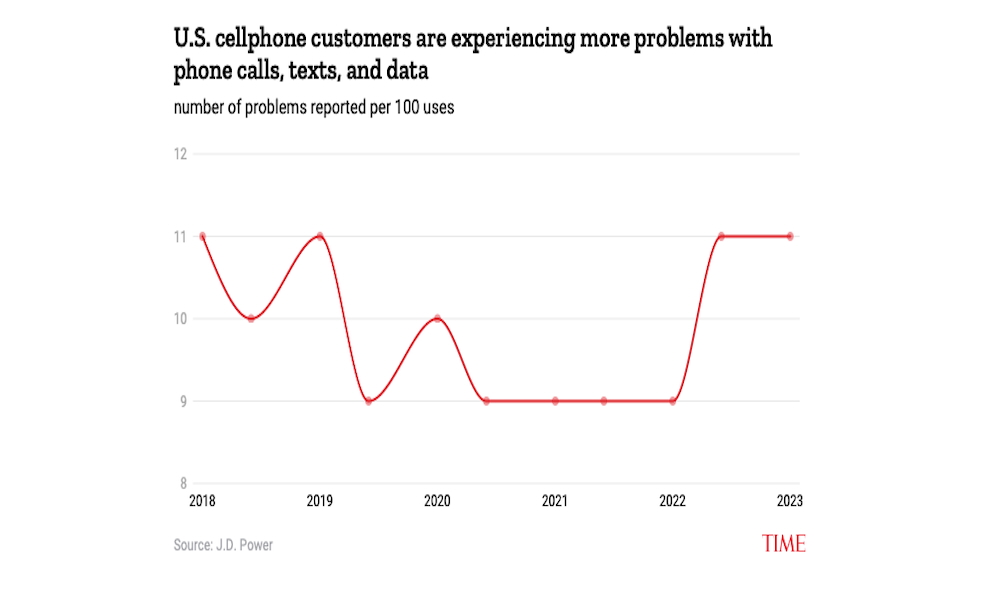Are You Living In or Near a Cell Signal Dead Zone?
 Credit: fizkes / Adobe Stock
Credit: fizkes / Adobe Stock
Toggle Dark Mode
If you want to keep up with work and family on the go, a reliable cellphone connection is basically a necessity. It’s hard to imagine cell dead zones still exist as we watch the race to build the best artificial intelligence unfold, but they do. In fact, they’re pretty common. Here’s an overview of what cell dead zones are, why they occur, and where they happen the most around the US.
A cell dead zone is any geographical area where mobile devices receive little or no signal coverage. You’ve been there. Even if you see one or two bars of signal, your call or connection could drop or be intermittent. Oftentimes, environmental factors are to blame, like hills, mountains, forests, or even buildings that can obstruct service. We’ve all driven through dead zones. Population density is another factor. Some rural areas with smaller populations will have less coverage because infrastructure providers aren’t investing in serving only a few customers. At the same time, existing infrastructure might not be sufficient to handle large influxes of people.
New standards and technology, like 5G, have brought faster data speeds and better coverage. However, dense infrastructure is still required for these to be effective. The Wireless Infrastructure Association (WIA) reports 153,400 purpose-built cellular towers were in operation in the US as of 2023. Building, maintaining, and operating this complex infrastructure takes 387,300 individuals, according to the WIA.
Despite this massive supporting infrastructure, TIME reported that cell customers were experiencing connectivity issues with calls, texts, and data during 11 of every 100 uses in 2023. Why is this happening? It’s complicated. However, the easiest way to understand the issue is the growth in the number of people using cell phones with larger data plans and a trend towards using phones for more and more activities that were once typically done on a computer with direct internet or Wi-Fi connection. This includes the explosion of people watching streaming content and joining video calls.
According to eSIM provider Holafly, Cincinnati, Ohio, is the worst US city for cell signals, with 534 complaints per million people. Other cities in the top 10 include Boulder, Colorado, Carlsbad and Irvine in California, and Scottsdale, Arizona. In reviewing cell network complaints by zip code, Holafly says even Manhattan’s 10018 has 808 complaints per million inhabitants. Why? Steel and concrete can block signals.
Are you living in or near any of the zip codes with the most complaints per million people? I do, and it’s pretty frustrating. There are certain areas in town I frequent where I can’t use my iPhone for anything within a couple of square miles. The problem hasn’t improved over the years; if anything, it’s only gotten worse.
While telecom companies are still expanding their infrastructure, they’re also driven by profit demands, not necessarily users’ needs. To further complicate things, new cell towers come with a host of regulatory and permitting hurdles like local zoning laws and environmental concerns. Add NIMBYs (not in my backyard) to the mix, and it’s easier to understand the challenges of expanding coverage.
Fortunately, telecom companies are partnering with local governments to build small cells. These are less conspicuous, lower-power antennas that can fill gaps in coverage. Eventually, direct-to-device (D2D) satellite coverage will also bypass cell towers altogether.
However, as of now, there’s still not a cohesive option readily available to the public. If you suffer from frequent signal loss, you may need to explore switching providers. Turning Airplane Mode on and off should also help you connect to the nearest tower in a pinch.
It’s clear that cell dead zones are a problem that needs solving. Unreliable connectivity on occasion is frustrating, but we’ve survived the minor inconvenience. As the problem persists, it exacerbates larger issues like safety concerns, economic growth, and educational gaps. Solutions are on the horizon, but they’ll take time. The digital divide is an important matter, and quality of access is just one of the elements all US citizens must be aware of to level the playing field.










